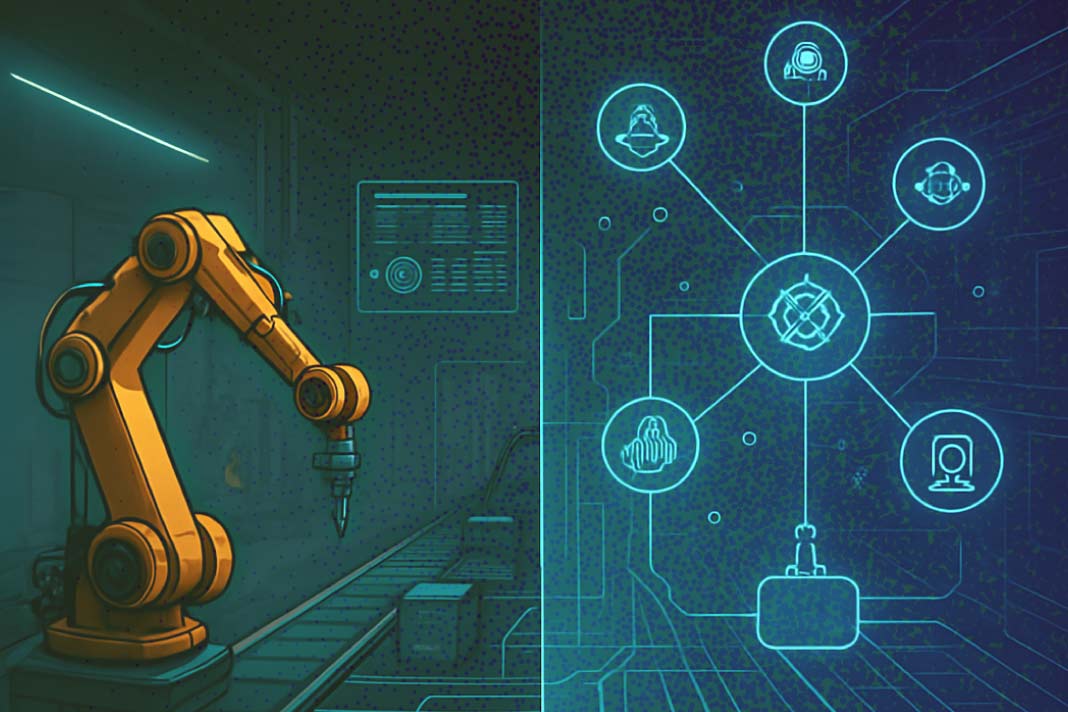MAGS and digital twins drive smarter, sustainable factories with real-time AI decisions, seamless interoperability, and industry-wide efficiency gains.
Across the manufacturing industry, organizations have embraced digital twins to maximize operational efficiency, automation, and productivity.
The Digital Twin Consortium defines a digital twin as a “virtual representation of real-world entities and processes, synchronized at a specified frequency and fidelity.” Digital twins provide a holistic, end-to-end data view across an entire organization, powered by domain knowledge and real-time data.
Today, Multi-agent GenAI Systems (MAGS) allow digital twins to go even further. Made up of multiple interacting GenAI-based agents, MAGS works together to solve operational challenges across the manufacturing industry, increasing production throughput and reducing maintenance planning time.
AI agents within MAGS will ultimately become fully autonomous – capable of building, maintaining, and operating their digital twins.
At the same time, the rise of the Model Context Protocol (MCP) – an open standard for connecting AI systems and data sources – will further position MAGS and digital twins as key enablers of next-generation manufacturing and help companies keep pace with the industry’s rapid evolution.
Empowering Efficiency and Sustainability
MAGS and digital twins are growing in popularity as the industry focuses on efficiency and sustainability. Manufacturers can build smarter operations, reducing utility usage, cutting costs, and improving energy efficiency at scale.
While traditional machine learning tools can make relevant predictions — about energy consumption, for example — with historical data and mathematical algorithms, MAGS goes further. By leveraging GenAI-based agents that can learn and adapt in real time, MAGS enables systems to make intelligent decisions, including predicting when and where resources will be needed and when they can be conserved, and proceeding to drive automated actions.
Paired with digital twins, manufacturers can effectively simulate and optimize energy use across entire facilities. For example, MAGS can detect when specific areas of a factory are unoccupied and automatically power down lighting, air conditioning, or idle machinery, lowering energy consumption without disrupting operations in other parts of the factory.
Interoperability is Imperative
Interoperability is critical in a company’s ability to stay agile and responsive to evolving manufacturing demands. However, today’s manufacturers often operate in technological siloes, with isolated digital twins and proprietary systems that duplicate efforts and limit visibility.
Companies that fully embrace MAGS and digital twin technology can unlock robust interoperability, empowering systems, platforms and tools to communicate and operate seamlessly across different vendors, departments and production sites worldwide.
When integrated with digital twin technology, MAGS can break down technological siloes. Unlike standalone systems, MAGS deploys its GenAI agents to analyze data and collaborate across systems to make faster, more informed decisions. These agents enable manufacturers to virtually simulate and coordinate everything from production scheduling to equipment performance across varying platforms, without relying on centralized control.
As manufacturing becomes increasingly digitized, industry-wide collaboration on interoperability standards – such as efforts by organizations like the Digital Twin Consortium – will be essential to harnessing the full potential of digital twins and MAGS, enabling seamless integration across systems and accelerating innovation at scale.
Manufacturers that invest in open, interoperable digital twin ecosystems will be best positioned to lead in the years ahead.
What’s Next: Model Context Protocol
As organizations increasingly adopt MAGS and digital twins, incompatibility has emerged as a common challenge between models and tools.
Until now, tool calling – the process of AI models interacting with external tools – has lacked standardization. Each large language model and agent framework has had its own way of calling tools, so if a manufacturer built custom tools for one model and later switched to another, they’d often have to rebuild or reconfigure those tools entirely – a time-consuming and expensive process.
The release of the Model Context Protocol (MCP) this past November aims to change that by acting as a universal tool-calling standard, or the “USB-C” of AI models. It provides a model-agnostic interface that allows any LLM or agent framework to communicate with tools in a standardized way, a major step toward tool interoperability in AI agent and digital twin ecosystems.
With MCP, the model simply communicates with the MCP server, which handles the tool orchestration underneath. This is a game-changer for manufacturing, where digital twins and MAGS are often interacting with dozens of legacy systems, sensors and machinery.
This evolution is already happening in sectors like mining, where major players have deployed fully autonomous mining vehicles. These vehicles not only operate independently underground but also monitor their own mechanical health, drive themselves to the repair dock when needed, automatically open a repair ticket, diagnose the issue and then trigger the appropriate response – all through tool calling of the agents.
We’re seeing a similar paradigm shift toward fully autonomous systems in manufacturing. For example, AI agents now monitor machinery health in real time – analyzing sensor data to predict failures before they happen. In quality control, AI-powered vision systems inspect products in real-time, automatically flagging defects and adjusting production settings to maintain quality standards without human intervention.
MCP represents a promising step toward standardized, scalable AI-powered manufacturing systems. As the protocol matures and becomes more developer and enterprise-friendly, manufacturers will be better positioned to take advantage of truly autonomous agents that can monitor, manage and optimize operations in real-time.
Looking ahead, the manufacturing sector is poised for even more transformative changes. As AI, digital twins and MAGS continues to advance, we can expect the rise of fully autonomous factories where AI agents manage every aspect of production, from initial design to final delivery. Enabling efficiency, predictive maintenance and dynamic resource allocation, these systems will empower more resilient and adaptable manufacturing ecosystems.
Companies that invest in these systems now will not only stay competitive, but also lead the next wave of industrial innovation. The path to a more sustainable and efficient manufacturing landscape tomorrow, begins with embracing the power of digital twins and MAGS today.



